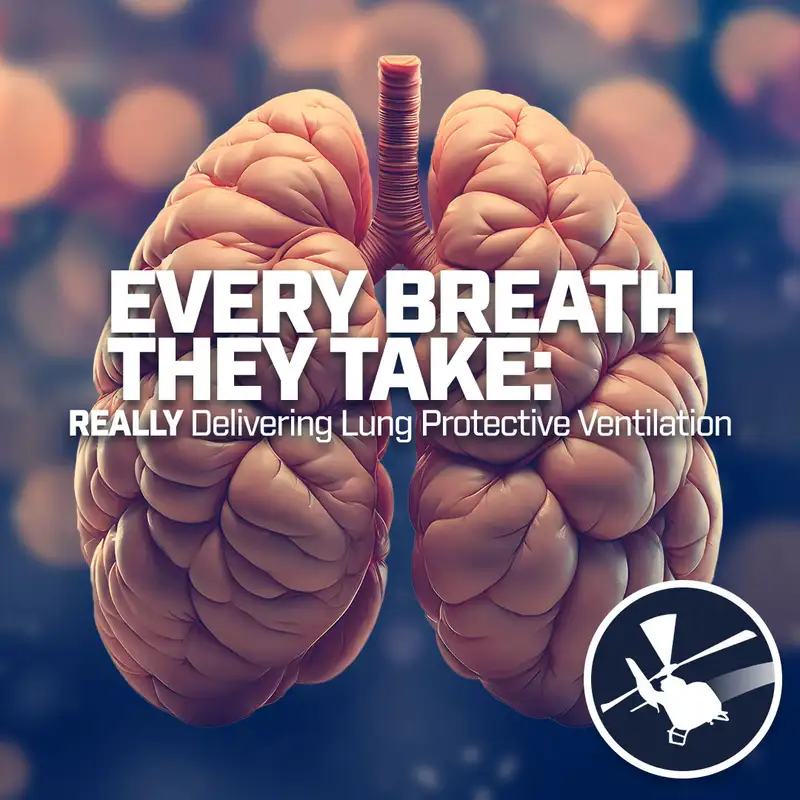Every Breath They Take: REALLY Delivering Lung Protective Ventilation
Download MP3The content of this podcast is based on medical fact and evidence-based practice from credible, authoritative sources but is not a substitute for your institution's policies, procedures, common sense, or good judgment. The views and opinions are those of Eric Bauer and FlightBridgeED in their entirety. This is the FlightBridgeED podcast, critical care and emergency medicine education for nurses and paramedics.
Hello everybody, and welcome back to the FlightBridgeED Podcast. I'm your host, Dr. Michael Lauria. I'm an Emergency Medicine, EMS, and Critical Care physician with a special interest and focus on Critical Care Transport, and I’m currently active as a flight and retrieval physician.
Today's episode is one I've been meaning to do for a while, and it’s on lung protective ventilation. The big question: Are we really protecting the lungs? Mechanical ventilation is a double-edged sword; while it's a technique to keep people alive and maintain oxygenation and ventilation, it can also cause significant damage to lung tissue. Sometimes, it may even make things worse.
Ventilator-induced lung injury, or VILI, is something we see all the time in the ICU, and it's something we strive to prevent as much as possible. In the context of today's discussion, I’ll be focusing on lung protective ventilation in the setting of Acute Respiratory Distress Syndrome (ARDS). While there are other conditions that can affect lung compliance, we’ll focus on ARDS because it’s a condition flight crews deal with frequently, and it’s become particularly prominent in the wake of COVID-19.
When done properly, lung protective ventilation can minimize secondary ventilator-induced injuries and improve patient outcomes. For a long time, we used a binary approach: obstructive ventilation for obstructive pathologies like COPD and asthma, and lung protective ventilation for everyone else, ventilating at 6 cc/kg. However, recent research, including the Prevent Trial, has shown us that in non-ARDS patients, it’s okay to ventilate a little more liberally, up to 8 cc/kg.
That said, the ARMA Trial in 2000 set the standard for lung protective ventilation, comparing tidal volumes of 12 cc/kg to 6 cc/kg. This was a significant reduction, but it remains unclear what the perfect tidal volume is for all patients. The key takeaway from the ARMA Trial is the importance of maintaining plateau pressures below 30 cm H2O, and ideally below 27 cm H2O.
We know from the ARMA trial that plateau pressures above 30 cm H2O significantly increase mortality. While we try to aim for lower pressures, there is some gray area. For instance, I consider plateau pressures between 27 and 30 cm H2O to be a caution zone, where we should carefully monitor and make adjustments as needed.
When plateau pressures exceed 30 cm H2O, we should reduce tidal volumes to decrease the strain on the lungs. A reasonable lower limit for tidal volume is around 4 cc/kg, provided we can maintain a pH of at least 7.15.
Now, this is all common practice for critical care transport, but I also want to talk about two newer concepts: driving pressure and mechanical power.
Driving pressure is the difference between plateau pressure and PEEP (Positive End-Expiratory Pressure). It’s essentially a surrogate for the amount of pressure required to deliver a specific tidal volume, given the lung’s compliance. This concept gained attention in 2015 when Amato and colleagues demonstrated that driving pressure, rather than plateau pressure, was the best predictor of mortality in ARDS patients.
The challenge with driving pressure is determining whether it’s simply a reflection of sicker lungs or if it’s actually causing more damage. Some evidence suggests we should aim for driving pressures below 15 cm H2O, even if the plateau pressure is acceptable. In certain cases, it may be worth reducing tidal volume further to decrease driving pressure.
The second concept I want to discuss is mechanical power, which refers to the total energy delivered to the lungs over time. This idea was introduced by Gattinoni and colleagues and involves more dynamic measurements, such as tidal volume, respiratory rate, and inspiratory flow.
Mechanical power may be a more comprehensive way to assess ventilator-induced lung injury. By considering how fast we deliver breaths, how often, and at what pressures, we can better understand how much strain we are putting on the lungs.
There’s growing observational data suggesting that mechanical power above certain thresholds (around 22-25 J/min) correlates with increased mortality. However, we’re still waiting for more robust randomized controlled trials to confirm this concept as a standard of care.
In practice, I keep these newer concepts in mind, but I always start with the basics: maintaining plateau pressure below 30 cm H2O, reducing tidal volumes as needed, and considering driving pressure and mechanical power when appropriate.
Ultimately, while some of these newer metrics may guide our decisions in the future, they should not yet be codified into practice without further evidence. That said, intelligent clinicians should be aware of them as potential tools in their ventilator management strategies.
That wraps up today’s episode on lung protective ventilation. Thank you all for tuning in, and as always, fly safe.
Creators and Guests


